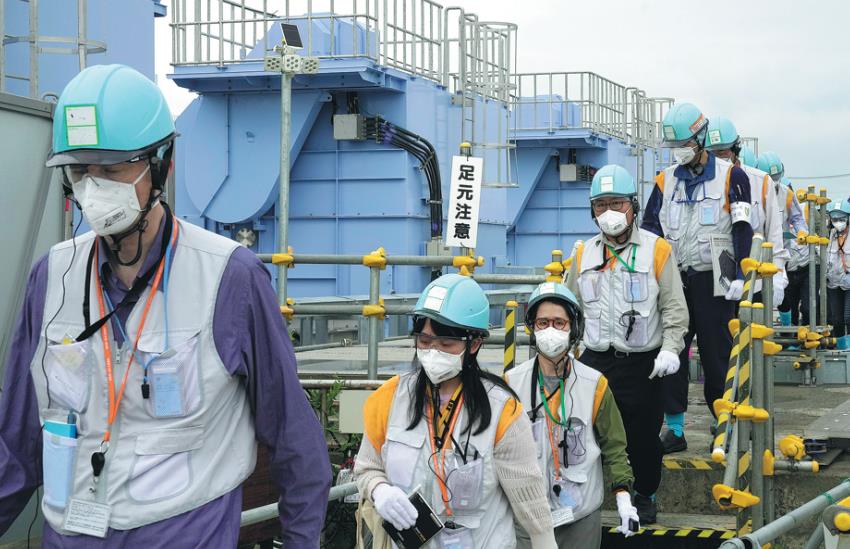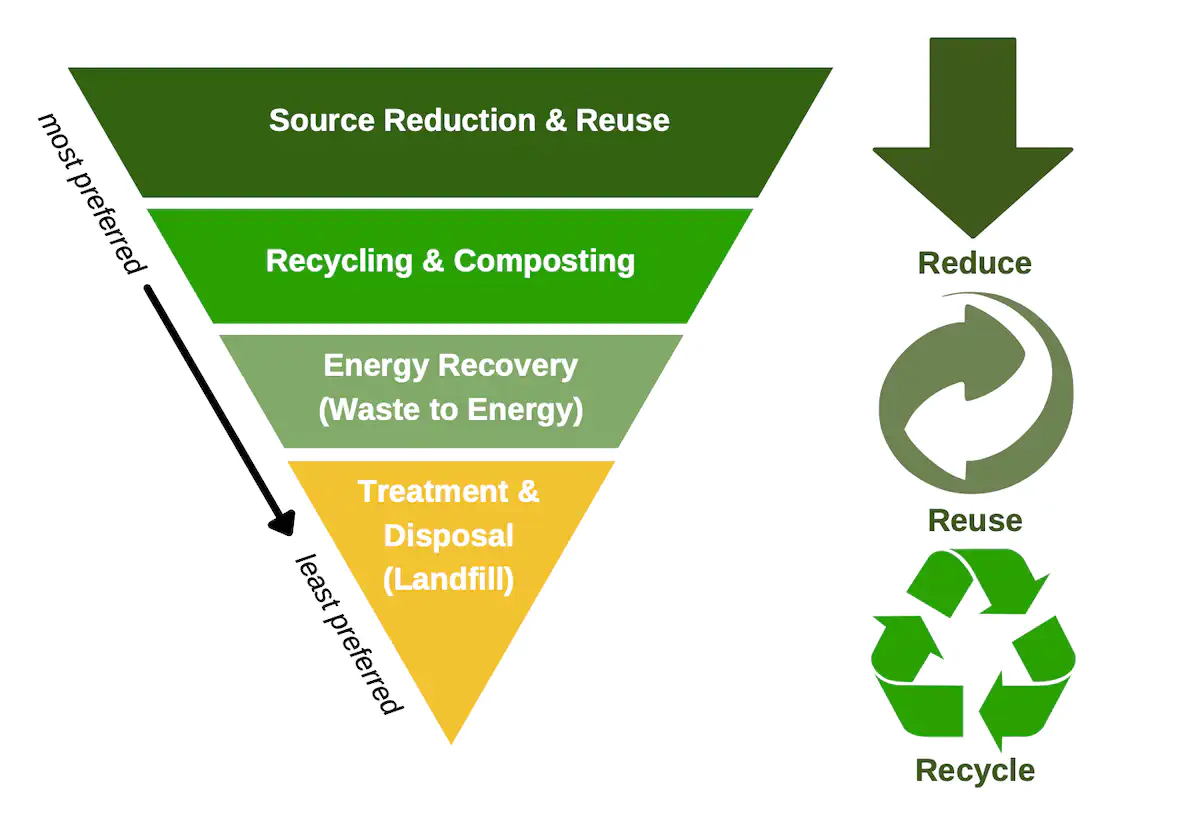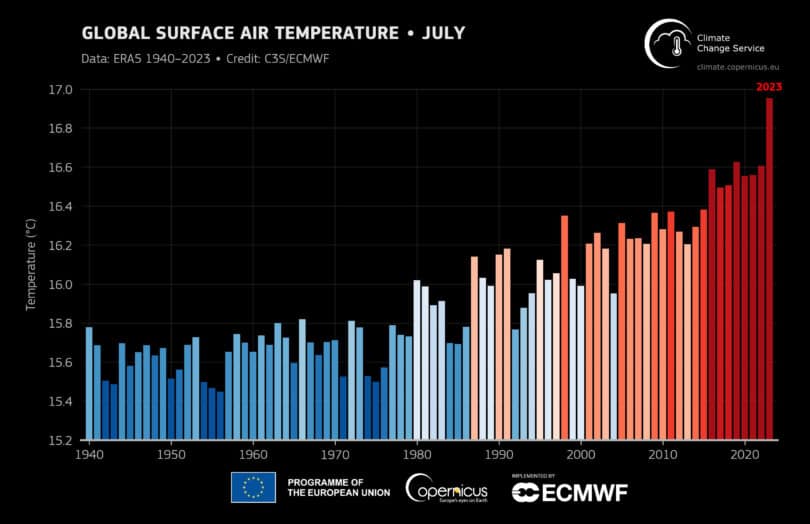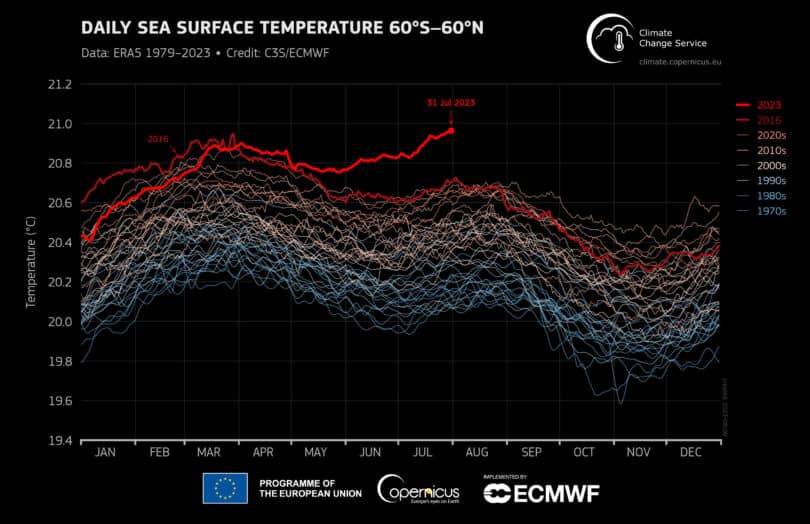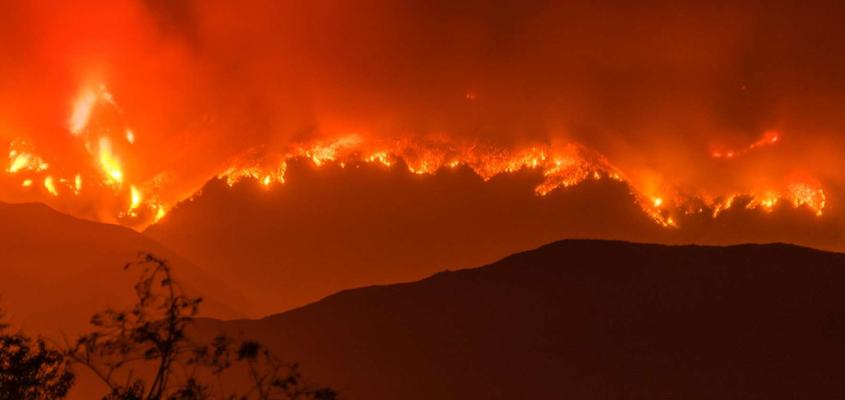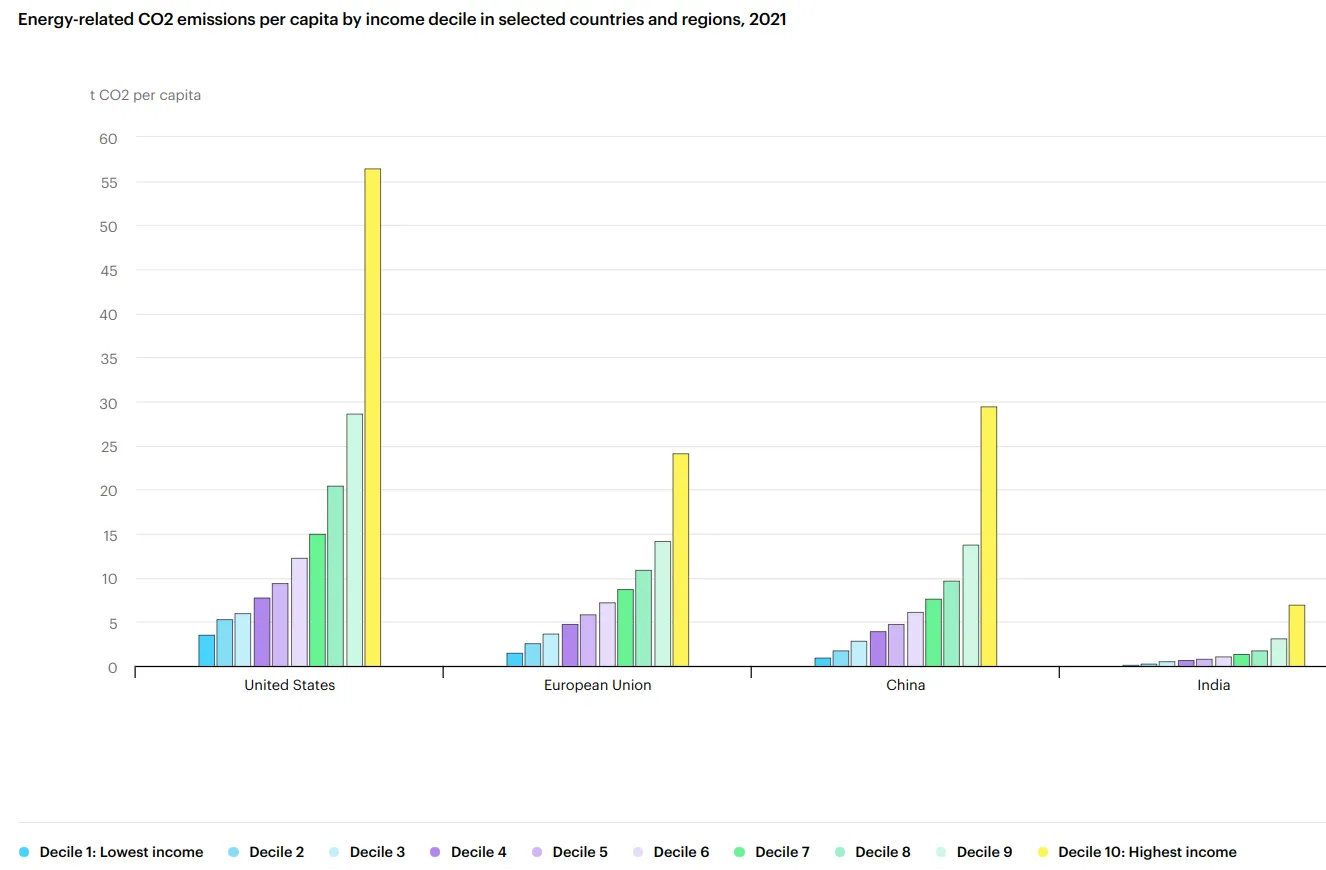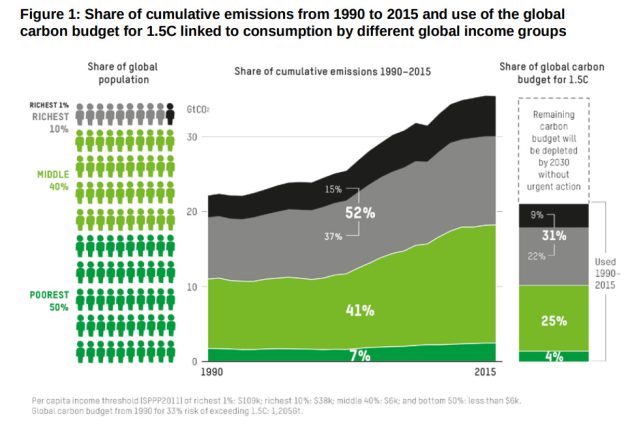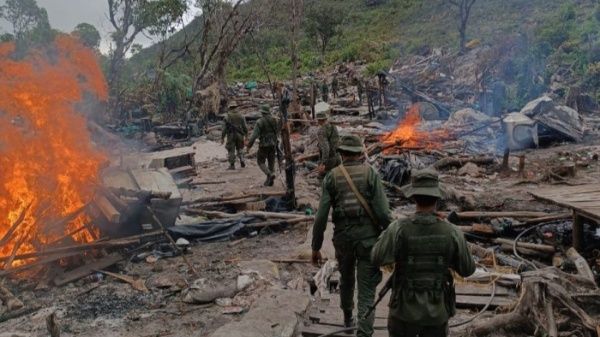 Another northern summer of climate catastrophe
Another northern summer of climate catastrophe
Originally published: Red Flag on July 29, 2023 by Nick Brown (more by Red Flag) | (Posted Aug 02, 2023)
“This could be the coolest summer of the rest of your life”, reads the headline of a recent Vox article, posted on 6 July, the same day the Earth experienced its hottest day ever according to the U.S. National Center for Environmental Prediction. The symptoms of global warming are appearing everywhere.
Canada is experiencing a wildfire season like never before. Huge blazes have reduced more than 10 million hectares of forest to ash. They have surpassed the North American record of almost 2 million hectares destroyed during the 2020 Californian fires. More than 120,000 people have been forced to evacuate their homes under a blanket of smoke.
The fires began to appear as early as May this year. Summer as we know it is getting longer, keeping the soil and the fallen plant debris drier for longer and creating huge loads of tinder.
There was no reprieve across the Atlantic as the heatwave hit Europe. Ground temperatures of up to 60C have been recorded in some locations across Spain. Nine countries across the Mediterranean are now ablaze.
Last year, an EU study estimated that more than 60,000 people across Europe died due to heat. This year is likely to be even worse. The vulnerable will be particularly at risk—the elderly and those who cannot afford to keep the air conditioning running.
The changing climate is not just producing heatwaves, but weather extremes. Residents of Italy’s Emilia-Romagna region are only just recovering from severe flooding, which claimed fourteen lives and left 36,000 people homeless.
“Six months’ worth of rain fell within 36 hours across Emilia-Romagna, one of Italy’s most important agricultural regions”, the Guardian reported.
The floods were preceded by a drought that had dried out the land, reducing its capacity to absorb water. More than 305 landslides were caused by the latest floods, which in turn either damaged or closed off 500 roads.
Yet, in the face of this catastrophe, the so-called leaders of our society—politicians, billionaires and government bureaucrats—seem to be on another planet. According to a 2021 Al Jazeera investigation, approximately 200,000km of oil and gas pipelines are planned for construction globally in coming years—costing a staggering USD$1 trillion.
There is too much money to be made from fossil fuels for those in charge to change course. The “big five” oil and gas companies—Exxon, Chevron, Shell, BP and TotalEnergies—made a combined profit of USD$200 billion last year alone. The rest of the industry made another USD$200 billion. For capitalists there is a relentless drive to “grow the business”. Apparently, USD$55.7 billion last year—or around USD$6.3 million profit taken every hour—was not enough for Exxon.
There are better ways to spend $400 billion, such as transitioning to renewables or repairing ailing healthcare systems. Instead, the money is going straight into the pockets of the wealthiest in our society to fund their private jet and super yacht acquisitions.
The entire global system of capitalism relies on the extraction of oil and natural gas to keep the wheels of profit turning. It’s not only the sale of these carbon-emitting resources, but they also provide the fuel for almost every other industry.
Perversely there are opportunities to profiteer from the changing climate. The latest boom in the industry has been north of the Arctic Circle, where permafrost, or soil that is usually permanently frozen, is rapidly melting due to rising temperatures. In 2008, the U.S. Geological Survey estimated that 13 percent of the world’s undiscovered oil and 30 percent of the undiscovered gas are in the Arctic region.
The changing Arctic landscape is an ecological disaster, but it is stimulating the expansion of fossil fuel projects in the U.S., Canada, Russia and Scandinavia. Projects such as ConocoPhillips’ Willow 30-year oil drilling lease or the new $45 billion LNG megaproject in British Columbia, green lit by Biden and Canadian PM Justin Trudeau, seek to take advantage of the new opportunities opened up by collapsing ecosystems.
The grotesque logic could not be clearer. Amid an ecological crisis of its own making, and which threatens the existence of human society as we know it, capitalism continues to profiteer even from the symptoms of the crisis.
https://mronline.org/2023/08/02/another ... tastrophe/
 The eco collapse we were warned about has begun
The eco collapse we were warned about has begun
Originally published: The Bullet on July 30, 2023 by José Seoane (more by The Bullet) (Posted Aug 02, 2023)
This article was produced by Globetrotter.
In 2023, different climatic anomalies have been recorded that set new historical records in the tragic progression of climate change at the global level. Thus, in June, the surface temperature in the North Atlantic reached the maximum increase of 1.3 degrees Celsius with respect to preindustrial values. In a similar direction—although in lower values—the average temperature of the seas at the global level increased. On the other hand, the retraction of Antarctic ice reached a new limit, reaching the historical decrease of 2016, but several months earlier in the middle of the cold season.
The combination of these records has led scientists who follow these processes to warn of the danger of a profound change in the currents that regulate temperature and life in the oceans and globally. The heat waves recorded on the coasts of a large part of the world—in Ireland, Mexico, Ecuador, Japan, Mauritania, and Iceland—may, in turn, be proof of this.
These phenomena, of course, are not limited to the seas. On Thursday, July 6, the global air temperature (measured at two meters above the ground) reached 17.23 degrees Celsius for the first time in the history of the last centuries, 1.68 degrees Celsius higher than preindustrial values; last June was already the warmest month in history. Meanwhile, temperatures on the continents, particularly in the North, also broke records: 40 degrees Celsius in Siberia, 50 degrees Celsius in Mexico, the warmest June in England in the historical series that began in 1884.
Higher Temperatures and Droughts
And its counterpart, droughts, such as the one plaguing Uruguay, where the shortage of fresh water since May has forced the increasing use of brackish water sources, making tap water undrinkable for the inhabitants of the Montevideo metropolitan area, where 60 percent of the country’s population is concentrated. This is a drought that, if it continues, could leave this region of the country without drinking water, making it the first city in the world to suffer such a catastrophe.
But the stifling heat and the droughts also bring with them voracious fires, such as the boreal forest fire that has been raging across Canada for weeks, with more than 500 outbreaks scattered in different regions of the country, many of them uncontrollable, and the widespread images of an apocalyptic New York darkened and stained red under a blanket of ashes.
This accumulation of tragic evidence, against all the denialist narratives, makes it undeniable that the climate crisis is already here, among us. It also indicates the absolute failure of the policies and initiatives adopted to reduce the emission or presence of greenhouse gases in the atmosphere. In this direction, in May of 2023, the levels of carbon dioxide (CO2) measured at NOAA’s global reference observatory in Hawaii reached an all-time high of 424 parts per million (ppm), becoming more than 50 percent higher than before the beginning of the industrial era and, those of the period January—May 2023, 0.3 percent higher than those of the same period of 2022 and 1.6 percent compared to that of 2019. According to the latest report of the United Nations Intergovernmental Panel on Climate Change (IPCC), the global surface temperature has risen faster since 1970 than in any other 50-year period for at least the last 2,000 years, the same period in which international agreements and national initiatives to combat the causes of climate change were deployed. The failure of these policies is also reflected, in our present, in the persistence and strength of a fossil capitalism and its plundering and socio-environmental destruction.
Not only have these so-called mitigation policies failed, but also the so-called adaptation policies aimed at minimizing the foreseeable impacts of climate change are weak or even absent.
In the same vein, the annual report of the World Meteorological Organization (WMO, Global Annual to Decadal Climate Update) released in May 2023 warned that it is very likely (66 percent probability) that the annual average global temperature will exceed 1.5 degrees Celsius in at least one year of the next five years (2023-2027), it is possible (32 percent probability) that the average temperature will exceed 1.5 degrees Celsius, and it is almost certain (98 percent probability) that at least one of the next five years, as well as the five-year period as a whole, will be the warmest on record; The IPCC has estimated serious consequences if this temperature is exceeded permanently.
El Niño
How close to this point will the arrival of the El Niño phenomenon place us this year and possibly in the coming years? El Niño is an event of climatic origin that expresses itself in the warming of the eastern equatorial Pacific Ocean and manifests itself in cycles of between three and eight years. With antecedents in the 19th century, in 1924 climatologist Gilbert Walker coined the term “Southern Oscillation” to identify it and in 1969 meteorologist Jacob Bjerknes suggested that this unusual warming in the eastern Pacific could unbalance the trade winds and increase the warm waters toward the east, that is, toward the intertropical coasts of South America.
But this is not simply a traditional meteorological phenomenon that recurs in irregular annual periods. It is not a natural phenomenon; however many attempts are made, time and again, to make invisible or deny its social causes. On the contrary, in recent decades, the dynamics of the climate crisis have increased both in frequency and intensity. Already in early 2023, the third continuous La Niña episode concluded, the third time since 1950 that it has extended over three years and with increasing intensity. Likewise, in 2016, El Niño led to the average temperature record reached by the planet. And different scientists estimate today that this Super El Niño may be repeated today with unknown consequences given the levels of greenhouse gases and the dynamics of the current climate crisis.
The banners of a change inspired by social and climate justice and the effective paths of this socio-ecological transition raised by popular movements are becoming more imperative and urgent today. It is possible to propose an emergency popular mitigation and adaptation plan. But to make these alternatives socially audible, to break with the ecological blindness that wants to impose itself, it is first necessary to break the epistemological construction that wants to inscribe these catastrophes, repeatedly and persistently, in a world of supposedly pure nature, in a presumably external field, alien and outside human social control.
This is a matrix of naturalization that, while excluding social groups and the mode of socioeconomic organization from any responsibility for the current crises, wants to turn them into unpredictable and unknowable events that only leave the option of resignation, religious alienation, or individual resilience. The questioning of these views is inscribed not only in the discourses but also in the practices and emotions, in responding to the catastrophe with the (re)construction of bonds and values of affectivity, collectivity, and solidarity—indispensable supports for emancipatory change.
https://mronline.org/2023/08/02/the-eco ... has-begun/
All policies are bound to fail unless they make the rich richer. Capitalism is doom.
******
Energy Destinies – Part 8: Pathways
Posted on August 3, 2023 by Yves Smith
Yves here. In his penultimate post in his series on the prospects for success in moving to new energy sources, Satyajit Das noted that most green energy programs assumed energy use drop by roughly 25%, and why history and trends suggested that that premise was very sketchy. Here, he gives a more complete discussion of the potential for demand reduction. He also provides a taxonomy of the overlapping phases of responses. Some cynics speculate that what looks like incompetence is actually a covert effort to curb energy uses. For instance, I gather that a right wing trope is that widespread US flight cancellations are to deter consumer air travel.
Das asked me to put this thank you at the top:
The author would like to thank readers and commentators, especially
engineers and scientists whose perceptive analysis on technical issues was
most helpful.
By Satyajit Das, a former banker and author of numerous works on derivatives and several general titles: Traders, Guns & Money: Knowns and Unknowns in the Dazzling World of Derivatives (2006 and 2010), Extreme Money: The Masters of the Universe and the Cult of Risk (2011), A Banquet of Consequences RELOADED (2021) and Fortune’s Fool: Australia’s Choices (2022)
Abundant and cheap power is one of the foundations of modern civilisation and economies. Current changes in energy markets are perhaps the most significant for a long time. It has implications for society in the broadest sense. Energy Destinies is a multi-part series examining the role of energy, demand and supply dynamics, the shift to renewables, the transition, its relationship to emissions and possible pathways Parts 1, 2, 3,, 4, 5 and 6 looked at patterns of demand and supply over time, renewable sources, energy storage, economics of renewables, the energy transition and the inter-action between energy policy and emissions. The last two parts outline the energy endgame. Part 7 examined the framework that will shape events. The final part looks at possible trajectories.
The world simultaneously faces two problems – dwindling fossil fuels and emissions. These can be addressed by reducing demand as well as increasing or managing supplies including the shift to lower emission renewable sources.
Demand Modification
Energy demand is a function of a number of factors: population, energy consumption per capita, and energy density relative to GDP. A critical externality is the emissions per capital or unit of GDP.
Unfortunately, there is little impetus to manage many of these variables. Political constraints around forced population control and expectation of perpetual improvements in living standards mean curtailing demand is not on the policy agenda.
But there is potential for greater efficiency of energy use. The Second Law of Thermodynamics, first identified by the French scientist Sadi Carnot in 1824, states that it is impossible for the energy from a single source to be converted into work without other effects, that is, some waste of energy is inevitable. This can be illustrated simply. Fossil fuel driven internal combustion engines have a thermal efficiency of around 40-50 percent for a petrol engine and slightly higher for a diesel. In normal use, the typical efficiencies are at the lower end of theoretical levels with much of the energy released dissipated mostly as waste heat. Land, sea and air transport combined have an average efficiencies of around 20 percent.
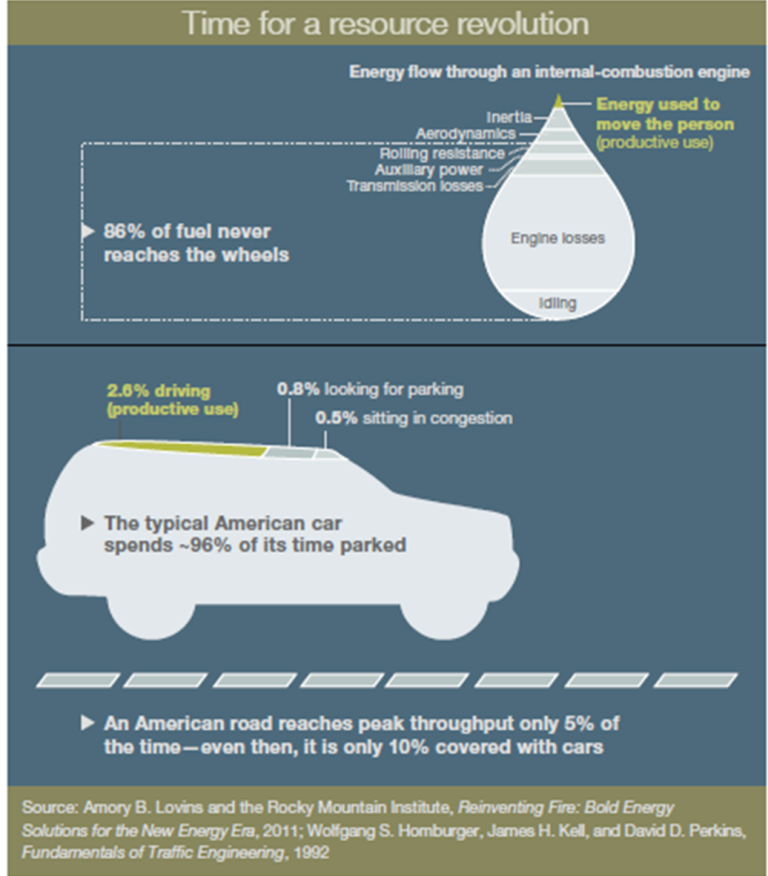
Cars are over-sized given that frequently it transports a single passenger in many cases for short distances. Sport-Utility Vehicles (SUVs) speak to vanities, insecurities and fears rather than practical need. Used for a small portion of their lives, the embedded energy in the materials used to construct vehicles is similarly wasted.
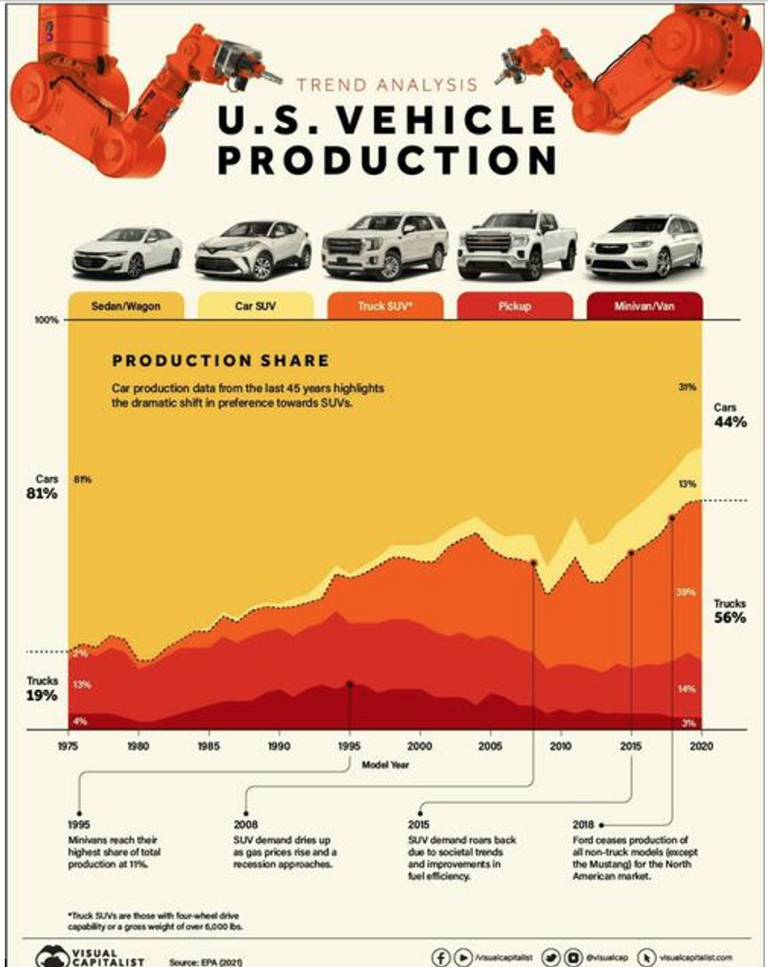
Heating and cooling building, which constitutes a significant proportion of power consumption, is wasteful due to poor energy efficiency. While newer designs have improved energy use, older buildings, which make up the bulk of housing and office stock, are difficult and expensive to retrofit.
Eating habits in many countries which seek produce which is out-of-season or must be transported across often large distances is similarly wasteful. With food waste running at around one-third of total production, significant amounts of the embedded energy in agricultural production and distribution is lost.
Power generation is similarly inefficient. US coal- and gas-fired power plants achieve average thermal efficiency of 32 percent and 44 percent respectively. Combined-cycle gas turbines, which use recovered waste heat to drive a steam turbine, have higher efficiencies of about 62 percent. Perhaps as much as two-thirds of primary fuel inputs end up as waste with only one third being used to power activities.
Unfortunately, there seems little interest in addressing demand which would, most likely, adversely affect living standards and levels of economic activity. Improving efficiency would be insufficient on its own and in any case is not exciting enough for many. This means that the primary focus is heavily skewed toward maintaining or increasing energy supply, with a heavy reliance on renewable technology. Given the limited window available to address issues of adequate supplies and emissions, this entails risk. It also may lock society into a spiral of disorder and decline.
The exact energy trajectory is affected by unpredictable events, such as the attempts to exclude Russian oil and gas from global markets. But like Dr. Elisabeth Kübler-Ross’ different stages of grieving , the likely pathway will have several phases – deals, disillusion and desperation, divides and disorder, and finally decline- though denial, anger, bargaining, depression and acceptance will feature as well.
Energy Pathway – Stage 1 Deals
The initial phase, underway since the late 1980s/ early 1990s, is focused on problem identification, evidence gathering, analysis and attempts to establish a framework for action. Starting with the 1992 Rio Earth Summit, the process became locked around reducing carbon dioxide emissions without a parallel consideration of energy needs.
The emphasis was on obtaining agreement without understanding of energy markets, physics and economics. Achievement was measured in dubious treaties. Politicians and lawyers compromised on hard parameters, accounting, funding and enforcement to maintain an appearance of progress. Generous government funding and subsidies combined with private funds from well-meaning philanthropists and individuals encouraged the usual grifters – investors, tech-entrepreneurs, NGOs and consultants – to dominate the process.
With energy supply continuing to flow at acceptable prices, at least until the Ukraine conflict, most citizens were marginally interested. With the ultimate consequences still far into the future, they placed faith in policymakers and belief that technological solutions which did not impinge on living standards were merely a matter of time.
This phase is now drawing to a close.
Energy Pathway – Stage 2 Disillusion and Desperation
In the second phase, a number of events coincide.
First, a realisation that things are slipping out of control emerges. The optimism built around “ what about” solutions evaporates in the face of the inescapable reality of the predicament. Like a terminally ill patient, denial and hope is replaced by other emotions.
Some manifestations are visceral – extreme climate events and interruptions to normal activities. Coastal communities and low lying areas face constant inundation. The areas of the earth which are difficult to inhabit expand. Climate refugees multiply. Other indicators are financial – rising food, energy, insurance and building costs. Vulnerability to things outside ordinary people’s control such as the Ukraine war and shortages of fuel and food become palpable.
Second, the lack of progress on slowing emissions and climate change are exposed. The realisation dawns that current plans will not limit carbon dioxide concentration to 450 parts per million from the current 410 because it would require an unlikely elimination or meaningful reduction in annual emissions within relatively short time frames. In July 2023, James Hansen, Makiko Sato and Reto Ruedy posted a new brief entitled – “The Climate Dice are Loaded. Now, a New Frontier?” The paper anticipated a more rapid pace of global warming given the acceleration of the Earth’s energy imbalance which was highly unpredictable in its consequences.
Third, the risk of an energy disruption becomes real. The slow roll-out and the efficacy of promoted solutions – solar and wind energy, batteries, EVs and hydrogen- is questioned. The much touted S curves of technological improvement and innovation prove illusory.
Fourth, there is increasing concern about slowdowns or peaking hydro-carbon production. Conventional oil production may be approaching its zenith. Surging production from non-conventional oil sources, such as US shale liquids and Canadian oil sands, helped offset this but these sources, especially US shale, may be depleting faster than anticipated. This would set in train a chain of events ultimately leading to much higher prices and supply shortfalls. The prospect of energy shortages begins to be understood as brownouts or load shedding become more likely.
Fifth, business and investor support for the energy transition diminishes.
In 2021, former Bank of England governor Mark Carney announced a much touted coalition of international financial companies to tackle climate change. The Glasgow Financial Alliance for Net Zero (GFANZ) included more than 450 banks, insurers and asset managers across 45 countries representing 40 percent of global financial assets. It was claimed that this coalition could deliver $100 trillion of private capital committed to hitting net zero emissions targets by 2050. By late 2022, a year after the original announcement, the alliance showed signs of strain as it failed to meet promises. Major banks and pension funds threatened to leave. By 2023, several participants had departedraising questions about its future. In June 2023, a GFANZ sub-group consisting of insurers withdrew after 23 US Republican state attorneys-general wrote to members alleging that the commitments violated antitrust laws.
The reduction in enthusiasm is apparent elsewhere. Only around 10 percent of investors at the annual general meetings of ExxonMobil and Chevron voted in favour of aligning emissions targets with the Paris agreement of 2015 although European fossil-fuel firms have been more supportive of similar proposals. Only a small majority (59 percent) voted in favour of a referendum in Switzerland for a new climate bill designed to cut fossil fuel use and reach net-zero carbon emissions by 2050. Investor environmental and social activism is fading generally.
In parallel, businesses exposed to climate change adjust their models. For example, banks stop lending to certain borrowers and insurers refuse to underwrite some risks. Prices adjust, sometimes dramatically.
Sixth, tensions between advanced and emerging nations boil over. Rich counties cutting their own emissions cannot halt global warming. Major reductions in emissions from countries like China and India are needed for progress. The reluctance of emerging countries to sacrifice their own economic development and the unwillingness or inability of advanced economies to pay appropriate compensation means progress stalls. An acrimonious rupture of global agreements or non-compliance is possible.
Finally, the cost becomes apparent. People question the spending in the light of its lack of success in generating the expected reduction in global carbon emissions. Write-downs of investments and bankruptcies highlight the mal-investment of private and public funds. The increased strain on public balance sheets to finance the energy transition in the face of other spending pressures becomes even more relevant.
The concatenation of factors affects the political sphere. In environment conscious Germany, the Green Party’s electoral position is increasingly affected by two opposing dissatisfied groups: one believes that the party, which is part of the governing coalition, is doing too much pushing up costs; the other takes the view that it is not doing enough – “green is getting too brown”. In mid-2023, voter support in percentage terms for the Greens had fallen from the low 20s to the mid-teens.
Policy makers most likely double down increasing funding for renewables and energy storage. Added resources for carbon capture and storage are provided. Lottery tickets for new technologies, such as geo-engineering, are purchased at huge cost.
In 2023, the European Union called for international efforts to assess climate interventions, including solar radiation modification. This would include stratospheric aerosol injections involving a vehicle around 20 plus kilometres above the earth shooting out micron-sized particles to reflect sunlight. Other idea include thinning cirrus clouds to allow infrared radiation to escape and launching sunshades or giant mirrors in space to deflect solar radiation. The technology for these solutions does not currently exist. The risk of side effects, such as changing weather patterns, damaging the atmosphere and redistributing the impact of climate change across ecosystems, are unknown.
The general attitude is that technology can solve all the problems created by technology, ignoring mankind’s indifferent ability to truly understand, anticipate or control the side-effects.
Many promoters glibly choose to forget that the current problems are actually the result of technological innovation, such as the use of hydro-carbons and the internal combustion engine. As the chaos theorist, played by Jeff Goldblum muses in Steven Spielberg’s original Jurassic Park scientists preoccupied with theoretical possibilities are oblivious to whether they should do something that is feasible irrespective of the consequences.
Anybody who questions the faith or points out the nudity of scientific emperors is vilified as backwards and engaged in linear, non-futurist thinking. In a reversal of physicist Richard Feynman’s belief, most prefer answers that cannot be questioned rather than questions that cannot be answered.
As desperation mounts, investment in energy sources such as nuclear may enjoy a resurgence as a source of cleaner power superior to fossil fuels as other options dwindle. In June 2023, Sweden’s parliament altered its energy plan to 100 percent fossil-free electricity from 100 percent renewables moving to build new nuclear plants. This reversed a vote 40 years ago to phase out atomic power. The US too is supporting nuclear power through tax credits through The Inflation Reduction Act. The 2021 Infrastructure Investment and Jobs Act created a $6 billion fund to keep existing plants running. The US government also offers developers a tax break to build reactors in fossil-fuel areas, such as coal-mining towns.
Newer, more compact modularised reactor technology offers promise although much of it is recycled older concepts. It must still overcome technological problems (fission plants remain basically military designs adapted for civilian use), sourcing fuel (uranium processing is dominated by Russia), and storage of radioactive waste. The debate around the release of radioactive waste water from the damaged Fukashima nuclear plant highlights the issues. Other issues include lengthy approval processes, shortages of skilled labour and cost. The US Department of Energy estimates that the costs of nuclear reactors at $6,000 to $10,000 per kilowatt-hour are well above the $3,600 per kilowatt-hour required to be competitive.
Safety issues remain. In his 2014 book Atomic Accidents: A History of Nuclear Meltdowns from Ozark Mountains to Fukashima, James Mahaffey, a long-time advocate of nuclear energy, argued that despite the belief, promoted by the industry and people including Bill Gates, that the risk of accidents in new generation nuclear reactors “would literally be prevented by the laws of physics …. trying to build something that will work perfectly for all time is a noble goal, but it is simply not possible”.
Another issue is proliferation and weaponization. Given that the demand for nuclear power will be greatest in emerging countries who need additional energy sources to achieve consumption and production targets to boost living standards to that already enjoyed by advanced countries, the problems of securing and controlling the use of fissile material is underestimated.
Accelerated development of fast breeder reactors, which generate more fissile material than they consume, is likely. Added efforts and investment in fusion technologies are made despite indifferent results over the last half a century.
The lengthy time needed to implement these projects, even if they are feasible, mean there is little or no immediate impact. Carbon dioxide emitting older fossil fuel driven generation facilities are placed on standby ‘just-in-case’ and eventually re-activated where possible.
Frenzied exhortations from people as varied as the UN Secretary General, climate scientists and Greta Thunberg disturb the sublime apathy of day-to-day life and generate an atmosphere of anxiety. The usual collection of snake oil salesmen appear. Given that hydrogen as an inexhaustible source of fuel was described in the late 19th century by Jules Verne’s in his 1894 novel Mysterious Island, the search for energy sources turns to sci-fi literature.
Facing deterioration in material conditions, the population rails against the lack of solutions ignoring that there may not be an easy answer to the dilemma? Facts do not depend upon the recipients ability to stomach it. With bromides and comfort blankets running out and a restive populace, desperation sets in as many governments struggle to keep energy supplies available and costs down to maintain electability. As Gray Davis, former Governor of California, once observed: “It’s a bummer to govern in bad times”.
Energy Pathway – Stage 3 Disorder and Divides
Stage 2 drifts into disorder as the ability to meet expectations of energy supplies and prices fracture. The forces identified in the previous stage intensify. Added pressures come from the need to prioritise essential services such as hospital and industries. National security requirements now become firmly entangled with other concerns.
The security apparatus globally is amongst the largest single consumers of energy. The US defence forces use vast amounts of electricity. It has large needs for hydro-carbon fuels to power its fleet of aircraft, ships and land vehicles. In 2016, for instance, its consumption was about 86 million barrels of fuel for operational purposes. Military aircraft are particularly thirsty. A B-2 stealth bomber carries nearly 100,000 litres (25,600 gallons) of jet fuel which is burnt at a rate over 15 litres (4 gallons) per mile. AKC-135R aerial refuelling tanker essential to extend the range of combat and transport aircraft consumes about 18 litres (4.9 gallons) per mile. Given the high power needs, electrification of these craft is unlikely with existing technology.
Other specific priorities come to the fore. Saudi Arabia uses 15 percent of the oil it produces to power desalination facilities which provide for roughly half its requirement of water.
Government must allocate an increasingly scarce resource between competing uses. Policy makers have to grapple with limiting demand outside of genuine need. Unfortunately, the definition of essential and wasteful depends on the viewpoint and especially the resources of the influential and how these can be mobilised.
The increasing shift to maximise energy security highlights differences between the energy rich and energy poor.
Domestically, energy poor nations face difficult choices. They can ration energy eliminating non-essential uses directly or use punitive taxes to discourage certain activities like car ownership, travel, air-conditioning, certain non-essential foods or large living spaces. Schemes may include replicas of Singapore’s Certificate of Entitlement (COE), a licence for owning a vehicle obtained by successfully bidding in an open bid uniform price auction. It grants the legal right of the holder to register, own and use a vehicle in Singapore for a period of 10 years. The cost of a COE can exceed the value of the car itself when demand is high.
Even energy rich nations institute similar policies to conserve resources although to a lesser extent. Internationally, energy rich countries have to decide whether to export energy, especially scarce hydro-carbons, or hoard them for future needs. Energy becomes weaponised in geo-political terms to an unimaginable degree.
The measures risk societal order and re-shape international relations.
Energy Pathway – Stage 4 Decline
In the final stage, energy demand must fit available supply, from whatever sources are available, as radical conservation is dictated by circumstances. Sir David King, a former UK chief scientist who once placed his faith in carbon capture, and the Cambridge Centre for Climate Repair now advocates the three R’s – reduction and removal of emissions and repair of damaged eco-systems, although the practicality of measures such as refreezing the Arctic are contentious.
The world must operate on the ‘theory of constraints’, developed by management theorist Eliyahu M. Goldratt building on the ideas of Wolfgang Mewes. It expands the cliché that no chain can be stronger than its weakest link. The theory of constraints emphasises identification of the constraint – the resources which cannot match the demands placed on it. The aim is then to work around this critical limitation. Adapted to the current context, as energy availability and cost becomes crucial, everything must recognise and accommodate that fact.
In the longer term, nation states must arrive at a sustainable energy equilibrium. Logically, this necessitates working out the available energy from a mix of nuclear, renewables and hydro-carbons then shaping energy demand around these constraints with a mix of regulations and taxes. Proper pricing of energy, taking into account long-term effects (such as depletion) and by-products (such as carbon emissions) is forced. Assuming the population cannot be reduced, at least in the short run, power usage per person must adjust.
The dynamics of Stage 4 depend on the speed of implementation and success of earlier actions to secure energy sources, such as nuclear power plants or fossil fuel supplies. To the extent that countries have failed to secure adequate energy supplies, emergency measures to balance supply and demand may entail restrictions on usage or out-right power shutdowns.
Unless the available energy sources are sufficient to accommodate normal demand and the cost does not rise significantly, a decline in economic activity would be expected. The magnitude of change will affect income levels, ability to meet commitments and also the stability of financial systems. For countries dependent on hydro-carbon export revenues, the falls in revenues may be significant affecting their prosperity.
If the per capita energy rations are lower than current levels and the cost significantly higher, then living standards and lifestyles will need to adjust. It may mean sacrificing the convenience of private cars for public transit and inefficient large homes in suburbia for smaller apartments located near workplaces. Other limits on power usage will need to be considered. Populations preoccupied with individuality and trust in techno-faith may find these choices unpalatable.
An energy divide within societies will emerge as a dangerous sub-set of inequality. As John Kenneth Galbraith observed in the Age of Uncertainty:
People of privilege will always risk their complete destruction rather than surrender any material part of their advantage. Intellectual myopia, often called stupidity, is no doubt a reason. But the privileged also feel that their privileges, however egregious they may seem to others, are a solemn, basic, God-given right.
Societies will struggle to maintain cohesiveness and order as accumulated expectations prove beyond the reach of most.
Globally, the risk of conflict over scarce energy rises. In the film Three Days of the Condor, an older more cynical CIA operative (Cliff Robertson) tells a younger researcher (Robert Redford) why Americans, or citizens in advanced economies, will support murder for petroleum: “Ask’em when they are running out. Ask’em when there’s no heat in their homes and they’re cold. Ask’em when their engines stop. Ask’em when people who have never known hunger start going hungry. You wanna know something? They won’t want us to ask’em. They’ll just want us to get it for ‘em.”
Whether our national and international political systems are capable of managing such stresses remains unknown.
Endgame
Just as the ready availability of cheap energy underpinned the rapid growth and improved living standards of the last two centuries, reduced supplies and higher costs will force a retrenchment. The exact configuration of the changes will differ between countries reflecting their unique circumstances. The overarching picture is a reversion to an earlier era when energy was more expensive and less plentiful. It will be complicated by a changed environment as higher temperatures will affect other essentials of survival such as food and water.
Our current civilisation was founded on both the past and the future. It was built on stored energy from sunlight. One gallon (3.78 litres) of gasoline requires around 1.5 gallons (5.7 litres) of crude oil which represents 89,000 kilograms (196,000 pounds) of ancient plant matter compressed by pressure and heat over millions of years. This precious resource accumulated over billions of years will have been consumed over a relatively short period of the planet’s history. It cannot be replaced in the span of our species.
At the same time, since the 1970s, modern economies have relied on ever larger amounts of debt. Such borrowings accelerate current consumption and spending against the promise of repayment. As debt levels have risen, more and more future income must be committed to paying it back. Higher levels of debt helped fund demands on available real resources, which are, in some cases, reaching the limits of supply.
The simultaneous pressures from the world’s energy and debt trajectories now shape the future. There is a subtle difference between the resource and financial economy. The former may decline gradually as supplies are used up. In contrast, the financial economy which inherently deals in current values of future cash flows discounted for timing may feel the pressures much earlier.
Author Jared Diamond, writing in 1999, argued that the worst mistake humans made was switching to agriculture. The addiction to fossil fuels and profligate energy consumption may prove equally catastrophic. It benefited a cohort of lucky sperm who were able to enjoy its bounty but leaves behind a toxic and uncertain legacy.
Future generations may look back at the era of fossil fuels with nostalgia and curse its legacies which they must navigate. They will bear the burden of the naïve belief that the climate problem can be solved by the energy transition financed by printing money or borrowing from those that will come after us. Former malapropism-prone Russian Prime Minister Viktor Chernomyrdim’s prognosis may be fateful: “We will live so well that our children and grandchildren will envy us!” All ages ultimately die by their own hand.
https://www.nakedcapitalism.com/2023/08 ... hways.html

